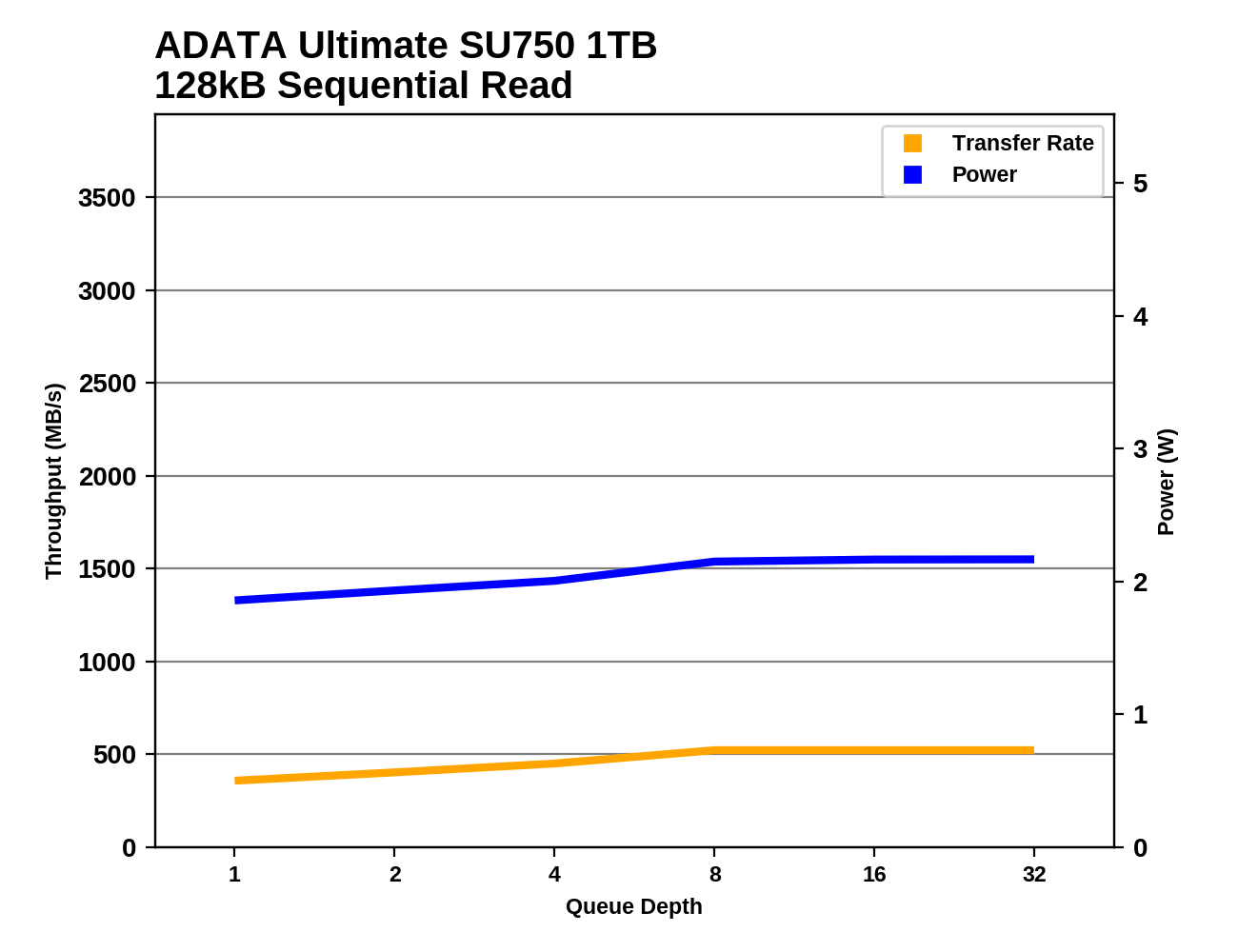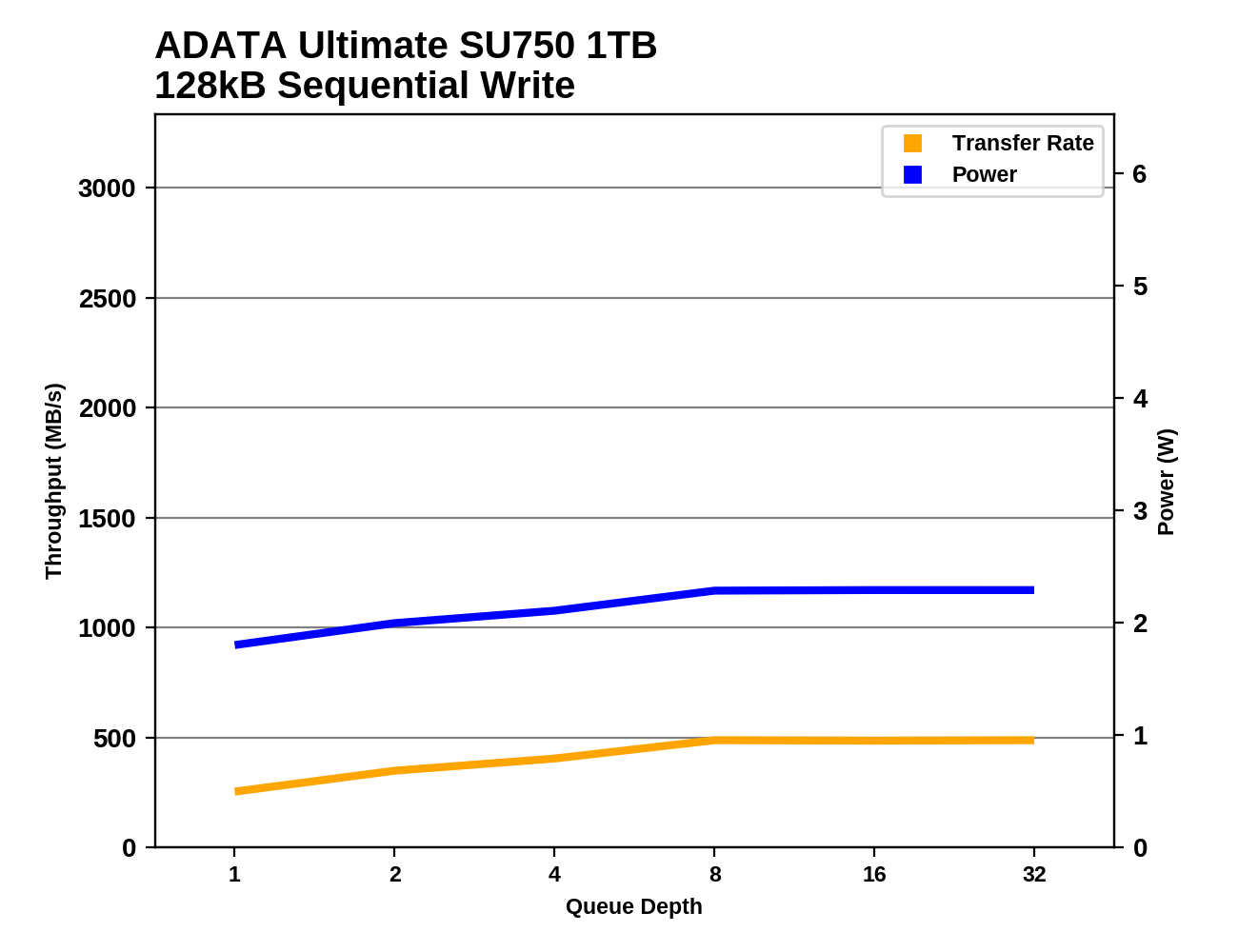The ADATA Ultimate SU750 1TB SSD Review: Realtek Does Storage, Part 1
by Billy Tallis on December 6, 2019 8:00 AM ESTSequential Read Performance
Our first test of sequential read performance uses short bursts of 128MB, issued as 128kB operations with no queuing. The test averages performance across eight bursts for a total of 1GB of data transferred from a drive containing 16GB of data. Between each burst the drive is given enough idle time to keep the overall duty cycle at 20%.

The burst sequential read performance from the ADATA Ultimate SU750 is a little bit slower than the mainstream SATA drives, but it's ahead of the other two entry-level drives.
Our test of sustained sequential reads uses queue depths from 1 to 32, with the performance and power scores computed as the average of QD1, QD2 and QD4. Each queue depth is tested for up to one minute or 32GB transferred, from a drive containing 64GB of data. This test is run twice: once with the drive prepared by sequentially writing the test data, and again after the random write test has mixed things up, causing fragmentation inside the SSD that isn't visible to the OS. These two scores represent the two extremes of how the drive would perform under real-world usage, where wear leveling and modifications to some existing data will create some internal fragmentation that degrades performance, but usually not to the extent shown here.

On the longer sequential read test, the SU750 is in last place and about 15% slower than the 860 QVO, though when reading back data that was written out of order, the 860 QVO is worse. The DRAMless Toshiba TR200 does well in both cases.
 |
|||||||||
| Power Efficiency in MB/s/W | Average Power in W | ||||||||
The power efficiency scores from the SU750 are again among the lowest, but unlike the random IO tests it isn't a big outlier in terms of either efficiency or total power draw.
 |
|||||||||
The SU750 does eventually reach sequential read speeds that more or less saturate the SATA link, but it requires a higher queue depth than any of the other drives in this batch. Power consumption is consistently just a bit higher than typical for mainstream drives, so at high queue depths its efficiency scores wouldn't be as bad as the low-QD scores shown above.
The SU750's sequential read speed at QD1 is definitely one of the slowest results we've seen, but at higher queue depths it is adequately fast and its power consumption is merely above-average and doesn't stand out from the crowd.
Sequential Write Performance
Our test of sequential write burst performance is structured identically to the sequential read burst performance test save for the direction of the data transfer. Each burst writes 128MB as 128kB operations issued at QD1, for a total of 1GB of data written to a drive containing 16GB of data.

The burst sequential write performance of the SU750 is clearly slower than mainstream SATA drives, but is nowhere near as bad as the Toshiba TR200's sub-HDD result.
Our test of sustained sequential writes is structured identically to our sustained sequential read test, save for the direction of the data transfers. Queue depths range from 1 to 32 and each queue depth is tested for up to one minute or 32GB, followed by up to one minute of idle time for the drive to cool off and perform garbage collection. The test is confined to a 64GB span of the drive.

On the longer sequential write test that brings in some higher queue depths, the SU750 falls a little further behind the mainstream SATA drives, and the Samsung 860 QVO crashes down to last place while the Toshiba TR200 starts to catch up with the SU750.
 |
|||||||||
| Power Efficiency in MB/s/W | Average Power in W | ||||||||
The power efficiency score for the SU750 during the sequential write test is not bad, for a change. The absolute power consumption is lower than most of the other drives, and the performance is good enough to make for decent efficiency.
 |
|||||||||
As with the sequential read test, the SU750 needs a fairly high queue depth to reach its full sequential write performance, which is competitive with mainstream SATA drives. It retains that performance for the rest of the test.
The low-QD sequential write performance from the SU750 could certainly be a lot worse, judging by some of the results from our archive. Across its entire speed range, the power consumption of the SU750 seems to be a bit below average, but never low enough to translate into impressive efficiency.












54 Comments
View All Comments
Billy Tallis - Saturday, December 7, 2019 - link
SSDs need to keep track of what physical location each logical block address is stored at. This info changes constantly because flash memory needs wear leveling, and this info needs to be accessed for every read or write operation the host system issues. Most SSDs use a flash translation layer that deals with 4kB chunks, which means the full address mapping table requires 1GB for each 1TB of storage. Mainstream SSDs use DRAM to hold this table, because it's much faster than doing an extra flash read before each read or write operation can be completed. DRAMless SSDs can cache a small portion of that table (typically a few MBs or tens of MBs) within the controller itself or using the NVMe Host Memory Buffer feature.DRAMless SSDs can work as a boot drive, but they're slower than mainstream drives that have the full 1GB per 1TB DRAM buffer.
PaulHoule - Tuesday, December 10, 2019 - link
The block size of an SSD is usually larger than the block size presented to the OS. The SSD can only erase a large group of blocks at once, so it has a flash translation layer that needs to keep track of things like "Block X seen by the OS is really stored in Subblock Y of Physical Block Z". It has to access that data every time it reads or writes, so it helps for that data to be in DRAM.DRAM is also good for write caching; under ordinary circumstances it is a big performance win to buffer writes to RAM before you really do them so you can bundle writes so the SSD can do them efficiently.
Current DRAMless SSDs keep the lookup tables on the SSD itself, which is slower than RAM.
There is a standard for an NVMe device to steal some RAM from the host, which might be a good option. Also there is a standard for NVMe zoned namespaces which would let the host manage the drive more directly, put that together with a revolution in the OS and you could get something which is simple, high performance, and cheap, but that revolution is happening in the data center now, not at the client.
Goodspike - Saturday, December 7, 2019 - link
What's with these brand names?To me Adata means no data. Sandisk means without disk. These are not good names for storage devices!
Gills - Saturday, December 7, 2019 - link
Realtek abandoned me on Windows 10 sound drivers for the many Toshiba POS terminals I'm tasked with updating from Windows XP and 7, so I'm not jumping onboard with anything they do anytime soon.supdawgwtfd - Saturday, December 7, 2019 - link
So going from one unsupported EOL O/S to another soon to be?That doesn't seem like good management.
Gills - Saturday, December 7, 2019 - link
Worded that poorly, sorry - we're upgrading everything to Windows 10.FunBunny2 - Saturday, December 7, 2019 - link
"So going from one unsupported EOL O/S to another soon to be?That doesn't seem like good management."
spend some time as the 'IT manager' at any small business; this sort of driving the infrastructure into the ground is SoP.
PeachNCream - Monday, December 9, 2019 - link
To be completely fair to RealTek, if your company's point-of-sale hardware originally shipped with XP, writing Win10 drivers for that audio hardware was probably not high on anyone's list of priorities. For point-of-sale computers manufactured and shipped with Windows 7, that might be more of a problem given the less obsolete nature of the equipment and yes, I understand that POS systems are expected to have a long service life, but XP was first up for sale in late 2001 and extended suport ended in 2014.Billy Tallis - Monday, December 9, 2019 - link
FYI, extended support for the last POS edition of XP only ended 8 months ago.PeachNCream - Tuesday, December 10, 2019 - link
Ah thanks. I didn't realize that POS variants had a longer support lifespan.